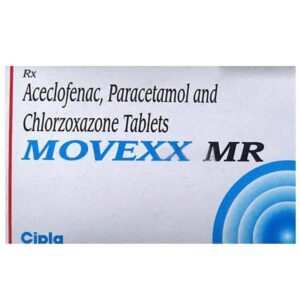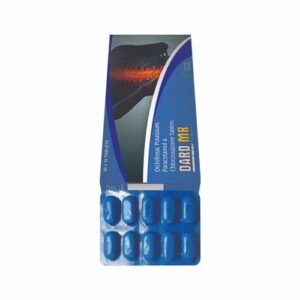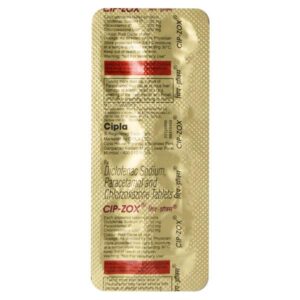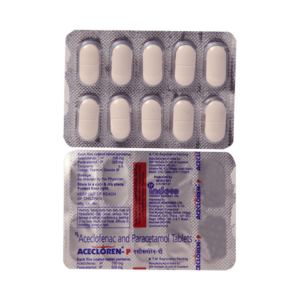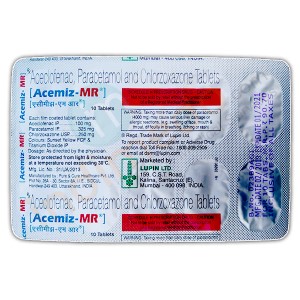PARACETAMOL (ACETAMENOPHEN) + ACECLOFENAC + CHLORZOXAZONE
Paracetamol (acetamenophen): Paracetamol, also known as acetaminophen, is a commonly used medication for pain relief and fever reduction. It belongs to the class of drugs called analgesics (painkillers) and antipyretics (fever reducers).
Paracetamol works by inhibiting the production of prostaglandins in the central nervous system. Prostaglandins are chemicals involved in the inflammation and pain response. By reducing the production of these chemicals, Paracetamol helps to alleviate pain and reduce fever. It is important to note that Paracetamol primarily acts on the brain and spinal cord and has a limited effect on peripheral tissue inflammation.
Paracetamol is used to treat mild to moderate pain, including headaches, toothaches, menstrual cramps, muscle aches, and pain caused by arthritis. It is also used to lower fever in conditions such as the common cold, flu, and other infections.
The recommended dose of Paracetamol varies depending on age, weight, and the specific condition being treated. It is important to carefully read and follow the instructions on the packaging or consult a healthcare professional for proper dosage guidance. Generally, the usual adult dose is 325-1000 mg taken every 4-6 hours, not exceeding 4000 mg in 24 hours.
When used as directed, Paracetamol is generally considered safe. However, like any medication, it may have potential side effects. Common side effects include nausea, stomach upset, and skin rash. In rare cases, Paracetamol can cause serious liver damage, especially when taken in higher doses or for extended periods. It is essential to avoid taking more than the recommended dose and consult a healthcare professional if symptoms persist or worsen.
It is important to note that Paracetamol may be an ingredient in combination products, such as cold and flu medications, so it is crucial to be aware of the total dose to avoid accidental overdose. Individuals with liver disease, alcohol dependence, or those taking other medications should consult a healthcare professional before taking Paracetamol.
Aceclofenac: Aceclofenac is a nonsteroidal anti-inflammatory drug (NSAID) that is commonly used for the relief of pain and inflammation in conditions such as rheumatoid arthritis, osteoarthritis, and ankylosing spondylitis.
Mechanism of Action:
Aceclofenac works by inhibiting the production of certain chemicals in the body called prostaglandins. Prostaglandins play a role in inflammation, pain, and fever. By reducing the production of prostaglandins, Aceclofenac helps to alleviate pain and inflammation.
Dosage:
The typical recommended dose of Aceclofenac for adults is 100 mg to be taken twice a day, preferably with food. However, the dosage may vary depending on the severity of the condition and individual patient factors. It is important to follow the prescribed dose and duration as directed by a healthcare professional.
Side Effects:
Like any medication, Aceclofenac may cause some side effects. The most common side effects include stomach pain, heartburn, nausea, vomiting, flatulence, dizziness, and headache. It may also lead to the development of gastric ulcers, bleeding, or perforation in some individuals. It is advised to use the lowest effective dose for the shortest duration possible to minimize the risk of side effects.
Aceclofenac can sometimes cause allergic reactions, characterized by symptoms such as rash, itching, swelling, and difficulty breathing. If any adverse reactions occur, it is important to seek immediate medical attention.
Additionally, Aceclofenac should be used with caution in individuals with a history of gastrointestinal ulcers, bleeding disorders, liver or kidney problems, or heart conditions. It is not recommended for use in pregnant women, especially during the third trimester, as it may harm the fetus.
It is essential to consult a healthcare professional or pharmacist for specific information regarding the use, precautions, and potential interactions of Aceclofenac with other medications or medical conditions.
Chlorzoxazone: Chlorzoxazone is a centrally acting skeletal muscle relaxant. It is primarily used for the relief of discomfort associated with acute, painful musculoskeletal conditions such as muscle spasms, strains, and sprains.
The exact mechanism of action of chlorzoxazone is not fully understood. However, it is believed to work by depressing the central nervous system, inhibiting polysynaptic reflexes in the spinal cord, and reducing muscle tone. This results in muscle relaxation and alleviation of pain.
The usual adult dose of chlorzoxazone is 750 mg to 1000 mg, taken three to four times a day. It is important to follow the dosing instructions provided by your doctor or pharmacist.
Common side effects of chlorzoxazone may include dizziness, drowsiness, lightheadedness, nausea, vomiting, stomach upset, and headache. These side effects are usually mild and temporary. Serious side effects such as allergic reactions, yellowing of the skin or eyes, unusual bleeding or bruising, and signs of liver dysfunction should be reported to a healthcare professional immediately.
Caution should be exercised when taking chlorzoxazone as it may cause drowsiness and impair cognitive and motor skills. It is advised not to operate machinery, drive, or engage in activities requiring mental alertness until the effects of the drug are clearly known.
Chlorzoxazone is generally well-tolerated, but it may interact with other medications. It is important to inform your doctor about all the medications you are taking, including prescription drugs, over-the-counter medications, and herbal supplements, to avoid potential drug interactions.

